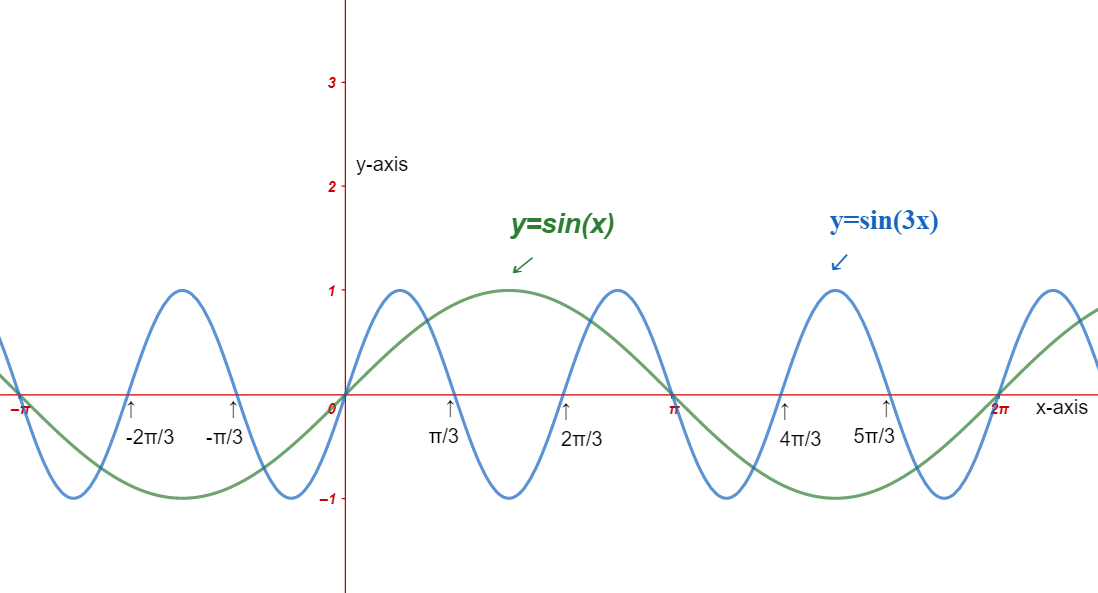
How do you use transformation to graph the sine function and determine the amplitude and period of \[y=\sin \left( 3x \right)\]?
Answer
528.6k+ views
Hint: This question is from the topic of trigonometry. In this question, we will draw the function of sin(3x) and then, find the amplitude and period of \[y=\sin \left( 3x \right)\]. In solving this question, we will first know the general form of sin function. From, we will understand the amplitude, phase shift, vertical shift and then period. After that, we will find the value amplitude and period. After that, we will draw the graph.
Complete step by step solution:
Let us solve this question.
In this question, we have asked to find the amplitude and period of \[y=\sin \left( 3x \right)\]. And, also we have to draw the graph for the same.
So, let us first know about the general form of sin function for finding the amplitude and period.
The general form is:
\[y=a\sin \left( bx+c \right)+d\]
Here, ‘a’ is amplitude, \[\dfrac{2\pi }{b}\] is period, \[\left( -\dfrac{c}{b} \right)\] is phase shift or we can say that the graph is being shifted by \[\left( -\dfrac{c}{b} \right)\] units towards x-axis, and ‘d’ is the vertical shift or we can say that the graph is shifted by ‘d’ units towards y-axis.
So, from the equation \[y=\sin x\], we can say that the amplitude is 1 and period is \[2\pi \].
Similarly, in the equation, we can say in the equation \[y=\sin \left( 3x \right)\] that the amplitude is 1 as same as in \[y=\sin x\] and period is \[\dfrac{2\pi }{b}=\dfrac{2\pi }{3}\]. And, phase and vertical shift will be zero as the value of c and d are zero.
Now, we will see the graph for the equation \[y=\sin x\] and \[y=\sin \left( 3x \right)\] in the following:

Here, we can see that in the function \[y=\sin \left( 3x \right)\], the amplitude is 1 that is same as \[y=\sin x\] but the \[y=\sin x\] function has period of \[2\pi \] and the function \[y=\sin \left( 3x \right)\] is having a period of \[\dfrac{2\pi }{3}\].
Note: We should have a better knowledge in the topic of trigonometry to solve this type of question easily. We should know the general form of sin function. The general form is:
\[y=a\sin \left( bx+c \right)+d\]
Where, ‘a’ is amplitude, ‘d’ is the vertical shift, \[\left( -\dfrac{c}{b} \right)\] is the phase shift, and \[\dfrac{2\pi }{b}\] is period.
Complete step by step solution:
Let us solve this question.
In this question, we have asked to find the amplitude and period of \[y=\sin \left( 3x \right)\]. And, also we have to draw the graph for the same.
So, let us first know about the general form of sin function for finding the amplitude and period.
The general form is:
\[y=a\sin \left( bx+c \right)+d\]
Here, ‘a’ is amplitude, \[\dfrac{2\pi }{b}\] is period, \[\left( -\dfrac{c}{b} \right)\] is phase shift or we can say that the graph is being shifted by \[\left( -\dfrac{c}{b} \right)\] units towards x-axis, and ‘d’ is the vertical shift or we can say that the graph is shifted by ‘d’ units towards y-axis.
So, from the equation \[y=\sin x\], we can say that the amplitude is 1 and period is \[2\pi \].
Similarly, in the equation, we can say in the equation \[y=\sin \left( 3x \right)\] that the amplitude is 1 as same as in \[y=\sin x\] and period is \[\dfrac{2\pi }{b}=\dfrac{2\pi }{3}\]. And, phase and vertical shift will be zero as the value of c and d are zero.
Now, we will see the graph for the equation \[y=\sin x\] and \[y=\sin \left( 3x \right)\] in the following:

Here, we can see that in the function \[y=\sin \left( 3x \right)\], the amplitude is 1 that is same as \[y=\sin x\] but the \[y=\sin x\] function has period of \[2\pi \] and the function \[y=\sin \left( 3x \right)\] is having a period of \[\dfrac{2\pi }{3}\].
Note: We should have a better knowledge in the topic of trigonometry to solve this type of question easily. We should know the general form of sin function. The general form is:
\[y=a\sin \left( bx+c \right)+d\]
Where, ‘a’ is amplitude, ‘d’ is the vertical shift, \[\left( -\dfrac{c}{b} \right)\] is the phase shift, and \[\dfrac{2\pi }{b}\] is period.
Recently Updated Pages
Master Class 11 Business Studies: Engaging Questions & Answers for Success

Master Class 11 English: Engaging Questions & Answers for Success

Master Class 11 Computer Science: Engaging Questions & Answers for Success

Master Class 11 Social Science: Engaging Questions & Answers for Success

Master Class 11 Maths: Engaging Questions & Answers for Success

Master Class 11 Biology: Engaging Questions & Answers for Success

Trending doubts
Differentiate between an exothermic and an endothermic class 11 chemistry CBSE

10 examples of friction in our daily life

One Metric ton is equal to kg A 10000 B 1000 C 100 class 11 physics CBSE

Difference Between Prokaryotic Cells and Eukaryotic Cells

State the laws of reflection of light

Explain zero factorial class 11 maths CBSE




